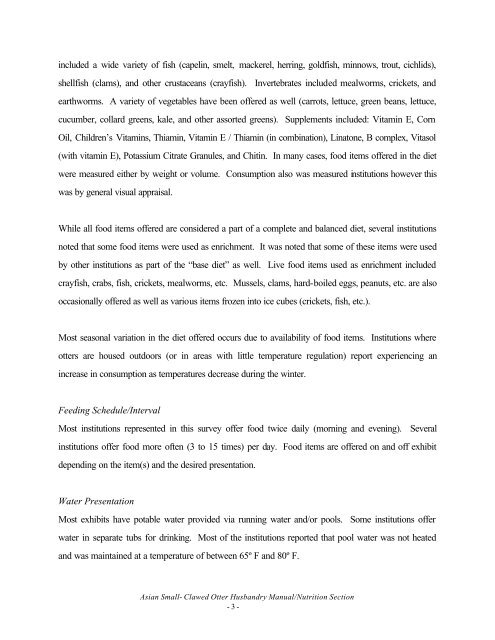Asian Small-Clawed Otter Husbandry Manual (1998)
Asian Small-Clawed Otter Husbandry Manual (1998)
Asian Small-Clawed Otter Husbandry Manual (1998)
Create successful ePaper yourself
Turn your PDF publications into a flip-book with our unique Google optimized e-Paper software.
included a wide variety of fish (capelin, smelt, mackerel, herring, goldfish, minnows, trout, cichlids),shellfish (clams), and other crustaceans (crayfish). Invertebrates included mealworms, crickets, andearthworms. A variety of vegetables have been offered as well (carrots, lettuce, green beans, lettuce,cucumber, collard greens, kale, and other assorted greens). Supplements included: Vitamin E, CornOil, Children’s Vitamins, Thiamin, Vitamin E / Thiamin (in combination), Linatone, B complex, Vitasol(with vitamin E), Potassium Citrate Granules, and Chitin. In many cases, food items offered in the dietwere measured either by weight or volume. Consumption also was measured institutions however thiswas by general visual appraisal.While all food items offered are considered a part of a complete and balanced diet, several institutionsnoted that some food items were used as enrichment. It was noted that some of these items were usedby other institutions as part of the “base diet” as well. Live food items used as enrichment includedcrayfish, crabs, fish, crickets, mealworms, etc. Mussels, clams, hard-boiled eggs, peanuts, etc. are alsooccasionally offered as well as various items frozen into ice cubes (crickets, fish, etc.).Most seasonal variation in the diet offered occurs due to availability of food items. Institutions whereotters are housed outdoors (or in areas with little temperature regulation) report experiencing anincrease in consumption as temperatures decrease during the winter.Feeding Schedule/IntervalMost institutions represented in this survey offer food twice daily (morning and evening). Severalinstitutions offer food more often (3 to 15 times) per day. Food items are offered on and off exhibitdepending on the item(s) and the desired presentation.Water PresentationMost exhibits have potable water provided via running water and/or pools. Some institutions offerwater in separate tubs for drinking. Most of the institutions reported that pool water was not heatedand was maintained at a temperature of between 65º F and 80º F.<strong>Asian</strong> <strong>Small</strong>- <strong>Clawed</strong> <strong>Otter</strong> <strong>Husbandry</strong> <strong>Manual</strong>/Nutrition Section- 3 -
















